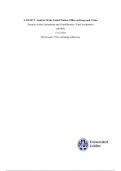A SWOC/T Analysis Of the United Nations Office on Drugs and Crime
Security Actors, Institutions and Constellations - Final Assignment
s2839032
17/12/2023
Word count: 2748, excluding references
, A SWOC/T Analysis of the United Nations Office on Drugs and
Crime
Introduction
Over the years, international organisations such as the United Nations (UN) have unified
numerous countries in economic, political, legal and security domains. Specifically in the
security domain cooperation has become increasingly vital, as security threats are expanding
to a transnational level, and beyond the governing abilities of single countries. These
international security actors, however, may also give rise to tensions of interest and
decision-making (Marks et al., 1996; Ličková, 2008).
Established in 1997, the United Nations Office on Drugs and Crime (UNODC) is such
an international security actor (UNODC, n.d.-a). The UNODC is a global department that
addresses international drug trade, combatting transnational organised crime, countering
terrorism and tackling corruption. It furthermore guards two of the United Nations
Conventions on Crime and the international conventions on drug control (UNODC, n.d.-a).
The UNODC mainly assists Member States in ratifying and implementing the mentioned UN
conventions by aiding with the formation of strategies and analyses, and by maintaining fair
justice systems.
In an ever-globalising world, the state is no longer the central power tasked with
policing (Loader, 2000). Loader (2000) provides a framework that categorises the different
levels of accountability and government policing. Applying this framework to the UNODC, a
policing above government can be identified, where measures are taken above the level of the
sovereign state due to the increasing globalising and transnational nature of criminal
activities.
While a highly-valued and deemed effective actor within the United Nations, previous
studies have evaluated the UNODC and highlighted areas for improvement (Office of
Internal Oversight Services (OIOS), 2020, 2021; Multilateral Organisation Performance
Assessment Network (MOPAN), 2020; Australian AID, 2012). This study will contribute to
this body of literature by conducting a Strengths, Weaknesses, Opportunities and
Challenges/Threats (SWOC/T) analysis on the UNODC. The SWOC/T methodology is
employed when analyzing strategic planning, thereby looking at both the internal and
external nexus of an organisation (Gürel, 2017). The SWOC/T provides an overview that
allows the maximisation of strengths and opportunities and minimises weaknesses and
1





